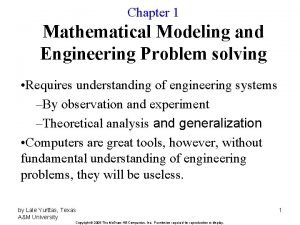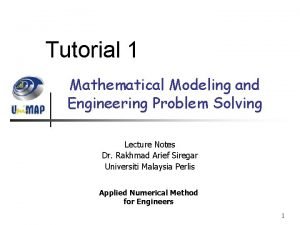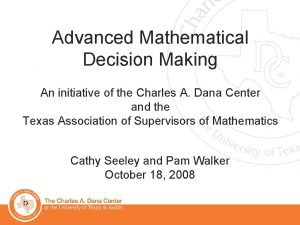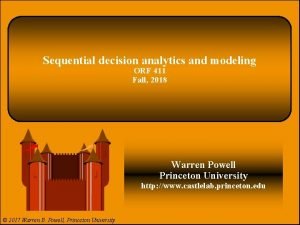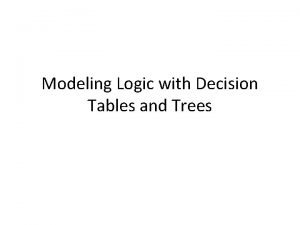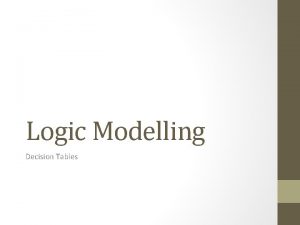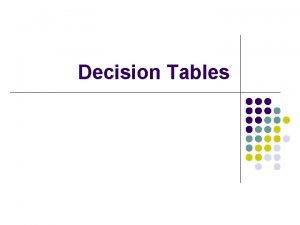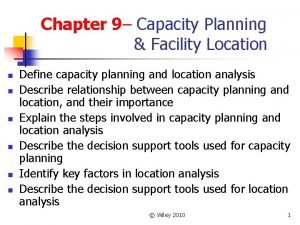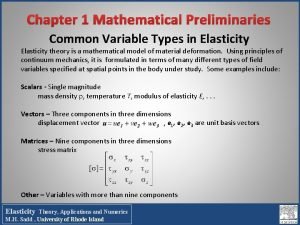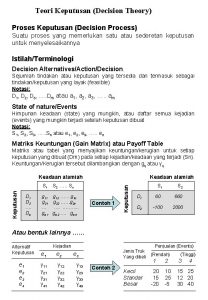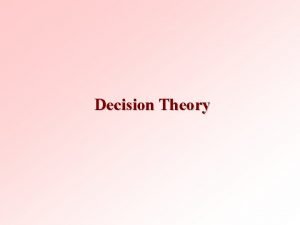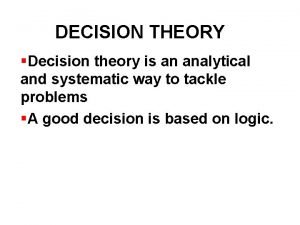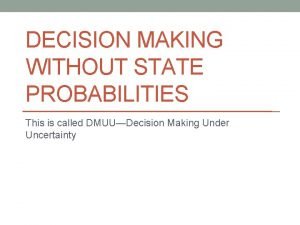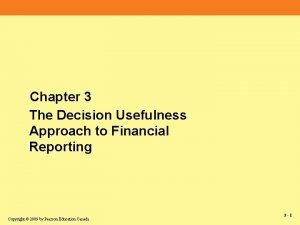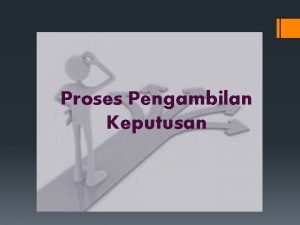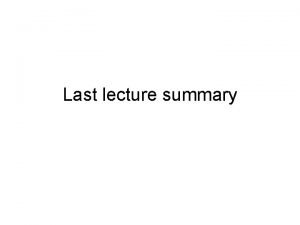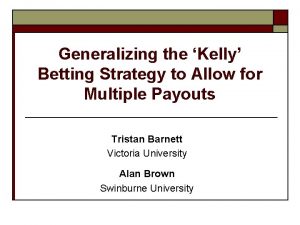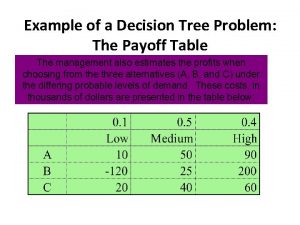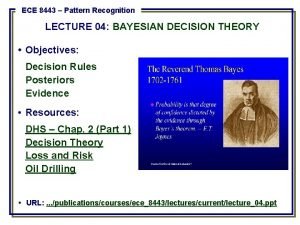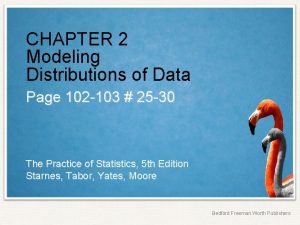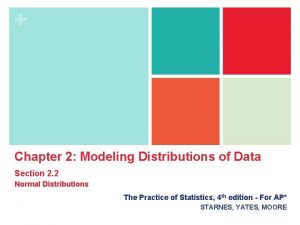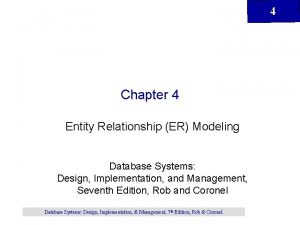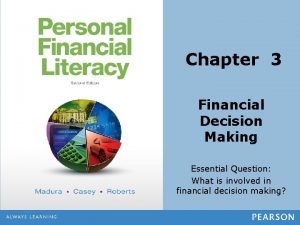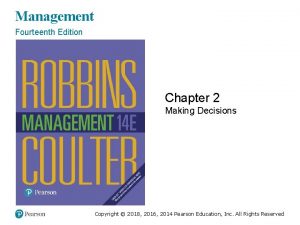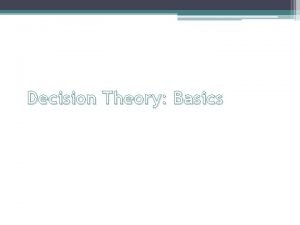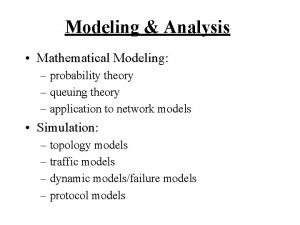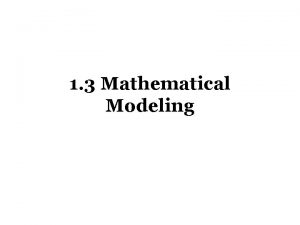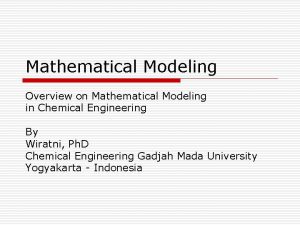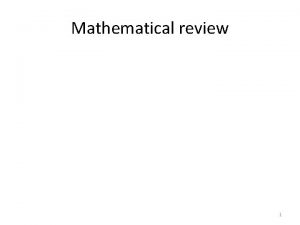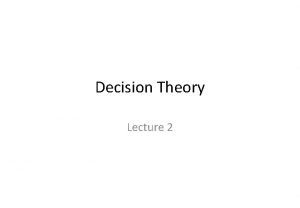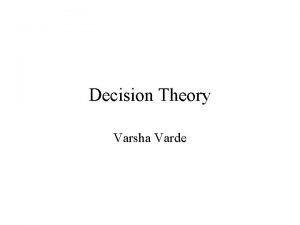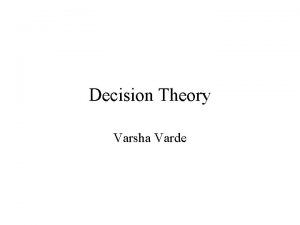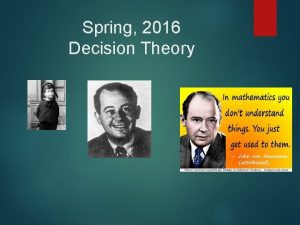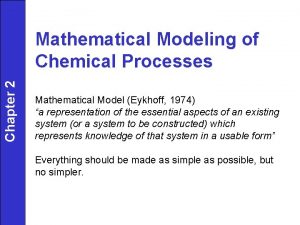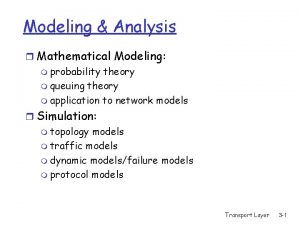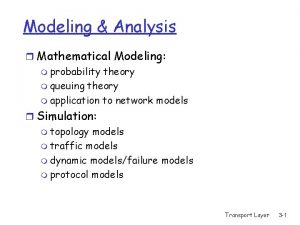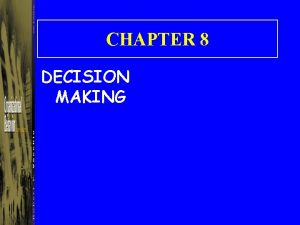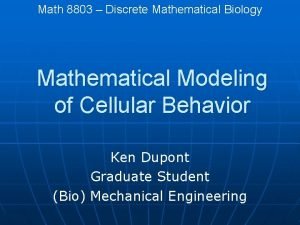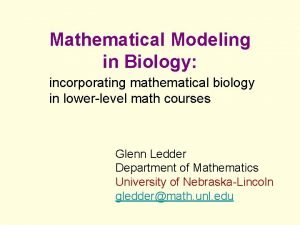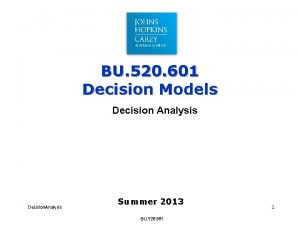Mathematical Modeling Chapter 7 Modeling with Decision Theory







































- Slides: 39

数学建模 Mathematical Modeling

Chapter 7. Modeling with Decision Theory 7. 1 Introduction 7. 2 Probability and Expected Value 7. 3 Decision Trees 7. 4 Sequential Decisions and Conditional Probabilities 7. 5 Appendix: Markov System 2


7. 1 Introduction Problem ¥ 1 ¥ 5 ¥ 2 You have ¥ 10 Decision Egg apple pen 1 10 0 0 2 0 5 0 3 0 0 2 4 1 2 1 5 3 1 1 …… …… 2022/2/1 Easy!!! Deterministic & !!! Decision Choice+ Designated Environments= Designated Results

7. 1 Introduction Problem How to make choice? 2022/2/1 Stochastic & Decision Choice+ Changeable Environments= indeterminate Results

Chapter 7. Modeling with Decision Theory 7. 1 Introduction 7. 2 Probability and Expected Value 7. 3 Decision Trees 7. 4 Sequential Decisions and Conditional Probabilities 7. 5 Appendix: Markov System 6

7. 2 Probability and Expected Value Characteristics: the probability of an event must be equal to or greater than 0 and equal to or less than 1. the sum of the probabilities of all possible events must equal 1. 2022/2/1 Probability in Decision Definition:

7. 2 Probability and Expected Value Example 2022/2/1 Suppose you are rolling a pair of dice once. If you roll a sum of 7 you win. We see that there is a total of 36 equally likely outcomes. Of these outcomes, there are 6 that result in a total of 7. The probability of rolling a 7 is

7. 2 Probability and Expected Value Example If after 5 quizzes you had three 80's and two 100's 2022/2/1 Weighted Average Definition:

7. 2 Probability and Expected Value Problem 2022/2/1 Remodeling Existing Golf Courses or Constructing New Golf Courses?

7. 2 Probability and Expected Value What about remodeling existing golf courses? The outcome winning has a payoff of $40, 000 with probability 0. 25, and the outcome losing, a payoff of $500 with probability 0. 75. Computing the expected value Stability Analysis How sensitive to the estimate of the probability of the award of a contract is the decision to remodel existing golf courses? To the net profit, if awarded the contract? 2022/2/1 Solutio n

7. 2 Probability and Expected Value 2022/2/1 Stability Analysis For constructing a new golf course, the current estimate of the probability of an award of a contract is 20%. How much would the probability have to increase for:

Chapter 7. Modeling with Decision Theory 7. 1 Introduction 7. 2 Probability and Expected Value 7. 3 Decision Trees 7. 4 Sequential Decisions and Conditional Probabilities 7. 5 Appendix: Markov System 13

7. 3 Decision Trees model of decisions and their possible consequences, including chance event outcomes, resource costs, and utility. It is one way to display an algorithm. Basic Structure : decision node: 2022/2/1 Definiti A decision on : tree is a decision support tool that uses a tree-like graph or

7. 3 Decision Trees uncertainty node 2022/2/1 Basic Structure :

7. 3 Decision Trees terminal node 2022/2/1 Basic Structure :

7. 3 Decision Trees Example 1 2022/2/1 Calculate the expand value !

7. 3 Decision Trees Example 2 The estimated demand probabilities are as follows: 2022/2/1 Recall the decision whether to manufacture and market outdoor wooden sheds presented in the chapter introduction.

7. 3 Decision Trees 2022/2/1 Solution s

Chapter 7. Modeling with Decision Theory 7. 1 Introduction 7. 2 Probability and Expected Value 7. 3 Decision Trees 7. 4 Sequential Decisions and Conditional Probabilities 7. 5 Appendix: Markov System 20

7. 4 Sequential Decisions and Conditional Probabilities consequence Decision 2 Decision 1 Conditional Probabilities conditional probability is a measure of the probability of an event given that (by assumption, presumption, assertion or evidence) another event has occurred. 2022/2/1 Sequential Decisions In many cases, decisions must be made sequentially.

7. 4 Sequential Decisions and Conditional Probabilities Problem 2022/2/1

7. 4 Sequential Decisions and Conditional Probabilities stop after either the first or the second spin and take the result of that spin Example: First spin $6, stop you will get $6 First spin $6, Second spun $4 stop you will get $4 Analysi s Clearly, after the first spin, if you take $10, you should stop, and you would spin again if you had $0. However, what about $4 or $6? Furthermore: 2022/2/1 Rule s. Every round, you have a maximum of 3 spins but may

7. 4 Sequential Decisions and Conditional Probabilities To solve this problem, we start at the final spin and work our way backward as follows: 2022/2/1 Soluti on: If your goal is to maximize profit over the 100 games, what should you do?

7. 4 Sequential Decisions and Conditional Probabilities If we play optimally, we will average $7. 375. If we play the game a large number of times, say 100, we expect to make about $737. 50 on average. If we pay more than $7. 375 to play each game, we will lose money!!!!! 2022/2/1 Further Analysis:

7. 4 Sequential Decisions and Conditional Probabilities Now, let's consider this process using a decision tree: 2022/2/1 First, we diagram the entire decision process, assuming we will take $10 anytime, and if we spin a $0 at spins 1 and 2, we will go to the next spin:

7. 4 Sequential Decisions and Conditional Probabilities Follow the optimal steps 2022/2/1 Next, we compute the expected value of the final uncertainty node as E(Spin 3) =$5. 00 and make the decision that after spin 2 to take $10 or $6; otherwise, go to spin 3.

7. 4 Sequential Decisions and Conditional Probabilities Cost $20000 Positive Results 0. 57 Alternatives low demand 0. 023 moderate demand 0. 468 high demand 0. 509 Build large plant $-120000 $100000 $200000 Build small plant $-20000 $50000 $90000 No plant 0 0 0 low moderate high demand Alternatives The Hardware & Lumber Company has to decide whether to hire the 0. 434 0. 543 market research firm. They would spend $20000 on hiring the 0. 023 firm. Build large $-120000 $100000 $200000 plant Negative Results 0. 43 Build small plant $-20000 $50000 $90000 No plant 0 0 0 2022/2/1 Problem 2 Hardware & Lumber Company Decision with Sequential Decisions

7. 4 Sequential Decisions and Conditional Probabilities Decision Tree: Without hiring the market research firm 2022/2/1 Hire the market research firm

Chapter 7. Modeling with Decision Theory 7. 1 Introduction 7. 2 Probability and Expected Value 7. 3 Decision Trees 7. 4 Sequential Decisions and Conditional Probabilities 7. 5 Appendix: Markov System 30

7. 5 Markov System 7. 5. 1 Markov chain is a process in which there are the same finite number of states or outcomes that can be occupied at any given time. The state do not overlap and cover all possible outcomes. 1 -p p 1 2 q 1 -q 马氏链 (Markov Chain)是时间、状态均为离散的随 机转移过程,对每个状态从当前状态向下一个状态的转 移概率之和为 1。(如对状态1:p + (1 - p) = 1)





7. 5. 2 Rental Car Company Model Solution: 汽 车 出 租 例 题 的 迭 代 解 n 奥兰多 坦帕 0 1 0. 6 0. 4 2 0. 48 0. 52 3 0. 444 0. 556 4 0. 4332 0. 5668 5 0. 42996 0. 57004 6 0. 428988 0. 571012 7 0. 428696 0. 571012 8 0. 428696 0. 571012 9 0. 428696 0. 571012 10 0. 428696 0. 571012 11 0. 428696 0. 571012 12 0. 428696 0. 571012 13 0. 428696 0. 571012 14 0. 428696 0. 571012

7. 5. 2 Rental Car Company p(1)=1; q(1)=0; for n=1: 15 p(n+1)=0. 6*p(n)+0. 3*q(n); q(n+1)=0. 4*p(n)+0. 7*q(n); end format short g p, q n=1: 16; plot(n, p, 'c-') hold on plot(n, q, 'm--') legend('奥兰多-', '坦帕--') xlabel('x') ylabel('y') —— 奥兰多 - - 坦帕


2022/2/1 Thank you
 No decision snap decision responsible decision
No decision snap decision responsible decision Slidetodoc.com
Slidetodoc.com Helen c. erickson
Helen c. erickson What is mathematical economics
What is mathematical economics Mathematical modeling of electrical systems examples
Mathematical modeling of electrical systems examples Mathematical modeling and engineering problem solving
Mathematical modeling and engineering problem solving Mathematical modeling and engineering problem solving
Mathematical modeling and engineering problem solving Advanced mathematical decision making
Advanced mathematical decision making Relational vs dimensional data modeling
Relational vs dimensional data modeling Sequential decision analytics
Sequential decision analytics Modeling logic with decision tables
Modeling logic with decision tables Cnnx11
Cnnx11 Decision logic table
Decision logic table Explain the decision tree modeling for capacity expansion
Explain the decision tree modeling for capacity expansion Decision tree and decision table examples
Decision tree and decision table examples Chapter 1 mathematical preliminaries
Chapter 1 mathematical preliminaries Introduction and mathematical concepts
Introduction and mathematical concepts Contoh soal minimax regret
Contoh soal minimax regret Decision making trees
Decision making trees Decision theory
Decision theory Evpi
Evpi Decision theory lecture notes
Decision theory lecture notes Importance of decision usefulness theory in accounting
Importance of decision usefulness theory in accounting Sargur srihari
Sargur srihari Pembuatan keputusan menurut herbert a. simon
Pembuatan keputusan menurut herbert a. simon Information theory decision tree
Information theory decision tree Decision theory
Decision theory Example of payoff table
Example of payoff table Bayesian decision theory in pattern recognition
Bayesian decision theory in pattern recognition Chapter 2 modeling distributions of data
Chapter 2 modeling distributions of data Chapter 2 modeling distributions of data
Chapter 2 modeling distributions of data Chapter 4 entity relationship (er) modeling
Chapter 4 entity relationship (er) modeling Chapter 6 prices and decision making assessment answers
Chapter 6 prices and decision making assessment answers Steps in decision making
Steps in decision making Chapter 2 economic systems and decision making
Chapter 2 economic systems and decision making Management chapter 5 planning and decision making
Management chapter 5 planning and decision making Chapter 3 financial decision making
Chapter 3 financial decision making Chapter 2 economic systems and decision making
Chapter 2 economic systems and decision making Copyright
Copyright Decision chapter 9
Decision chapter 9





